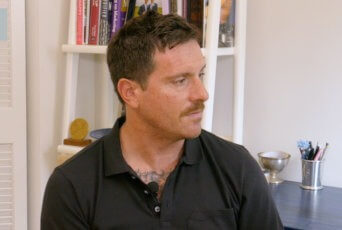Whitney Tingle had struggled with severe cystic acne ever since puberty, and had tried seemingly everything to get it to go away, including some shockingly aggressive treatments laden with side effects. But nothing the doctors recommended worked, and eventually she decided she had to figure it out herself. She dove into the world of nutrition, searching for the best foods for clear skin, and discovered how connected diet is to every aspect of our health — a discovery was the catalyst for co-founding Sakara Life, a clean meal and supplement delivery service. Read on to learn Whitney’s full story, as well as the best foods for skin repair and more.
*This is a short clip from our interview with Whitney Tingle. Click here to watch the whole thing.*
You can also listen to an audio version of our interview with Whitney Tingle on The WellBe Podcast.
Struggling with Severe Cystic Acne and Hitting Rock Bottom
Tingle developed severe cystic acne when she hit puberty, and it continued on through her teenage years and into her twenties. During those years, she searched desperately for a way to clear her skin, but nothing worked. “I tried everything you could think of, because I had big red painful cysts all over my face,” she says. “And skin is something you wear on your face. I would try to hide it with makeup, but I couldn’t hide it, and it affected my confidence, my mental health, how I showed up at work, in my relationships, in my dating life, and every aspect of my life. I was really desperate to try and find something to fix it.”
She did rounds and rounds of antibiotics, a decision which she regrets now that she knows how antibiotics can negatively impact your gut health. “Doctors at the time, they didn’t know about the microbiome, and they didn’t know about the damage that chronic use of antibiotics can do to the body,” Tingle says. “They thought that they were helping me, and that acne was just caused by bacteria on my skin.”
There were also lasers, which would remove layers off of her face in an attempt to kill the bacteria causing her severe cystic acne, leaving her with weeks of recovery after each treatment. She even went to the lengths of trying Accutane, a very aggressive drug with a frightening list of potential side effects.
“I think a lot of people think that because it’s passed by the FDA and doctors prescribe it, that [Accutane is] safe, but it’s a really serious drug,” Tingle says. She explains that because of the risk of birth defects, her doctors required her to take birth control while on the drug, as well as sign an agreement asserting that if she were to get pregnant, she would have an abortion. They also prescribed her Prozac to prevent suicidal ideations, another Accutane side effect.
At that point, Tingle had moved from her hometown of Sedona, Arizona to New York City, and was working in finance. She’d been thrust into the fast-paced life of Wall Street, working crazy hours and living a lifestyle that contributed to stress, sleep deprivation, and poor nutrition. Part of the culture of her job involved going out after work with clients or coworkers for drinks and appetizers — and we’re not talking sparkling water and roasted veggies here, it was cocktails and fried foods night after night.
“All of that was having an effect on my body and my skin, and I wasn’t realizing it quite yet at the time,” Tingle says. At that point, the severe cystic acne wasn’t her only issue. She was also dealing with chronic yeast infections, anxiety, and digestive issues like constipation, but didn’t yet have an inkling that they were all stemming from the same root cause.
She was desperate to find a solution, and believed that New York City, with the best of the best of everything, would have a dermatologist who could cure her severe cystic acne. “I’m reading all these glossy magazines and seeing all these names of dermatologists with their Upper East Side offices,” says Tingle. “So I just went one by one to go and see them to see if somebody had a different answer for me, something that I hadn’t tried yet, some magic cure. And one by one, they just wanted to write me another prescription.”
As much as Tingle wanted to take the doctors’ advice and believe that this next treatment could finally fix her skin, she knew deep down that she wouldn’t find an answer in pharmaceuticals or medical procedures. “I just had this voice inside of me that was shouting, ‘Don’t do it. It’s not the answer. You have to go inside and figure out the root cause that is creating this acne on your skin,’” she says. “It was like this lightbulb went off: the acne is not the problem. The acne is the symptom of something bigger going on inside.”
Turning to Food, and Finding Answers
At the same time that Tingle reached the end of her rope, her childhood friend Danielle Duboise found herself in a similar situation. She’d also moved from Sedona to New York City, and was working her way through medical school while also continuing the yo-yo dieting that she’d done for most of her life. Finally, one particularly drastic attempt to drop some weight landed her in the hospital, and she knew that she needed to make some major changes.
“When she came out [of the hospital], we had this ‘Aha’ moment,” says Tingle. “We needed to figure out: what does true health and true nutrition look like? It wasn’t for anybody else, it was for ourselves. We needed to figure it out so that we could survive. We needed to stop going to extremes to fix our bodies, but instead heal ourselves, and heal our bodies, and work with nature in order to get the results that we were looking for in a healthy way.”
They both felt strongly that they should turn to nutrition to find their path to healing. They’d begun to learn about the importance of gut health, and how your diet has a direct impact on your skin via the health of your microbiome. Tingle knew that rather than searching for the best prescription or procedure, she should be looking for the best foods for skin repair, the best foods for clear skin. (“My big realization was that I didn’t have a skin problem, I had a gut problem,” she remembers.) Duboise decided to leave medical school for nutrition school, and they both immersed themselves in research.
Their search for answers cast a wide net: they read clinical studies about the gut and microbiome, and learned all there was to know about epigenetics, macrobiotics, and other elements of food and nutrition science. They also looked at the nutritional philosophies of ancient modalities that have been around for thousands of years, things like Ayurveda and Taoism.
They took all of these learnings and began to look for patterns, to tease out the elements that were indisputable. “We saw that a lot of these different philosophies, even modern Western medicine, were saying the same thing,” says Tingle. “So we started to pull these threads together and say, ‘Okay, these are the things that we believe to be true, that we believe make sense. It’s logical. You don’t have to be a PhD or food scientist for these things to make sense.”
With these indisputable nutritional tenets established, they came up with what they call the “Nine Pillars of Nutrition,” then used these pillars to begin creating recipes. When they started eating solely food that followed these principles, the results were striking. For the first time in years, Tingle’s inflammation started to go down, and her digestive system started working again, and Duboise saw similar changes. “It was life-changing,” Tingle says. “Everything just started to come back into balance.”
They sensed that the solution they’d found to their own health problems could also be a solution to other people’s health problems, and so they set about creating what would become Sakara Life. Tingle left Wall Street to devote herself to building the business, which today has evolved from a meal delivery service to a one-stop shop for clean nutrition and the best foods for skin repair. They offer three different meal programs, as well as supplements, snacks, teas, and more (and WellBe readers can get 20% off their first Sakara Life purchase with the code SAKARALOVE20!).
The Best Foods for Skin Repair (and Overall Health)
Tingle and Duboise took everything they learned from their research and put it into their meal programs and supplements for Sakara Life. But the great thing about these fundamental nutrition principles is that all of us can start implementing them right now, just by changing the way that we shop and eat.
If you’re struggling with severe cystic acne or other skin problems (or another chronic health issue, like poor digestion), shifting your diet can be a game-changer, as Tingle learned. Here’s what she found out about the best foods for skin repair and the do’s and don’ts of eating for clear, radiant skin:
- DO eat foods with a high water content: Tingle recommends fruits and vegetables like romaine lettuce, melons, and cucumber, all of which have over 90% water content. “When they go into your body, that hydration goes to hydrate your body,” she says.
- DON’T eat foods with a long shelf life. “In order to get that long shelf life, the water is taken out of the food because water creates life, and so you have to remove all of that so that bacteria doesn’t grow on your shelf,” Tingle says. So this means avoiding shelf-stable, processed foods like chips and crackers, as well as refrigerated foods that last forever, like cured meats, cheeses, pickles, and olives. “These things that are made to last a long time need to suck hydration out of your body in order to be digested.”
- DO eat lots of leafy greens. Tingle aims for six cups of leafy greens per day, and recommends others set the same goal. “Maybe it doesn’t happen every day, but it’s an easy thing to set your mind to: ‘Okay, I’ll put some spinach into a smoothie in the morning. Okay, I’ll add greens to this sandwich that I was gonna eat. Oh, well, I didn’t get my six cups yet and it’s already dinner time so I better make myself a big green salad with lots of vegetables in it for dinner.’ Just making it a piece of your lifestyle, something you’re thinking about.”
- DON’T get stuck in a food rut. As we learned in our interview with Dr. Will Bulsiewicz, it’s not just about getting in a certain quantity of fruits and vegetables, it’s also about eating lots of different kinds of plants, since each species feeds different bacteria in your gut, and you want a diverse microbiome. Most people eat between 7 and 12 different types of plants per week, while the Sakara Life signature nutrition program includes more than 70 different plant species in each day. Tingle recommends starting small, aiming to just throw in a couple fruits or veggies you don’t normally eat the next time you’re in the produce aisle.
- DO hydrate. Tingle shoots for 3 liters of water a day. Water helps keep your digestive system running smoothly, while also hydrating your entire body, including your skin. But make sure that water is filtered properly! And if you must reach for a bottled water brand, read this first.
- DON’T forbid foods. Tingle believes that making any foods or food groups off-limits can create an unhealthy relationship with eating, which makes living an overall healthy lifestyle unsustainable. “I’ll eat any food when I want to,” she says. “But the majority of the time, I try to eat clean and get my leafy greens in and get lots of vegetables in.”
As you can see, choosing the best foods for skin repair doesn’t mean eating a certain list of magical, skin-clearing foods. Rather, it’s more about an overall shift in both mindset and eating habits, which prioritizes food diversity and hydration and leans mostly plant-based. Tingle recommends focusing on one change at a time and building from there. Once you’ve started regularly getting in your six cups of greens a day, for instance, you can then start introducing more diversity into your diet. “These little steps will start to make big impacts on your body over time without you even realizing,” she says.
“Eat Clean, Play Dirty”: Moving Forward with Balance
When Tingle first started eating for her skin, she was very diligent: no alcohol, no caffeine, no foods that didn’t adhere to the nutritional principles they’d established. But as her skin cleared up and her gut grew stronger, she was able to move toward a more intuitive, less rigid lifestyle. She now sees her diet not as a short-term fix for her severe cystic acne, but rather a lifestyle that she embraces. She believes that if others want to heal their chronic issues and feel their best, they need to do the same.
“For most chronic issues, if it’s chronic, then it means that it’s coming from something that you’re doing on an everyday basis,” she says. “So you need to change your living, your lifestyle, your habits.” She acknowledges that this can be very difficult, because many of these habits have been ingrained for years and have entrenched social, cultural, or emotional roots. But she also believes that when people understand their why, and when they begin to think of these changes as a shift in lifestyle rather than a set of restrictive rules, amazing things can happen.
“This is not, ‘I’m gonna do it for a certain amount of time and give up,’” she says. “This is, ‘I’m going for it, and if I fail one day, that’s fine because tomorrow is the next day and I’m still in this. It’s still not a diet. This is just life and this is what life looks like now.’” She explains that when you’re looking to heal an issue, you may need to be extra diligent for a period of time in order to give your body the space it needs to heal, but that once you’re feeling good as new, you can loosen things up a bit.
This idea is encompassed in the philosophy “eat clean, play dirty” (which is also the title of Tingle and Duboise’s book), which essentially means that if you usually support your body with clean food, plenty of water, and other nourishing habits like exercise and proper sleep, then it’s okay if you stray toward less-nourishing vices sometimes. By making healthy choices the majority of the time, you create a resilient body that can handle the stress of a fudgy brownie, a couple cocktails, a sedentary week.
“It’s a pendulum, right? Sometimes you’re going to be on the ‘play dirty’ side a little bit more — you’re going on vacation, it’s somebody’s birthday, you’re celebrating with your in-laws and you don’t have control of what you’re eating,’” says Tingle. “Then when you get back home, you swing to the other side and you’re more diligent about your food and your lifestyle, in order to get back to your balance point where you know you feel good.”
Have you noticed the impact your diet has on your skin? What changes — good or bad — have you seen? Share in the comments below!
Watch our full interview with Whitney Tingle to hear about the resistance she faced from her peers and colleagues when she began adopting a healthier lifestyle, why she believes self-criticism and judgement is actually selfish, how helping others allowed her to move on from negative thoughts about her skin, how something called “regenerative farming” can contribute to better gut health, the fertility challenges she faced and how she overcame them, how your poop can be a clue to what’s going on with your health, and much more.
You can also listen to an audio version of our interview with Whitney Tingle on The WellBe Podcast.
The recovery story above is anecdotal and specific to this particular individual. Please note that this is not medical advice, and that not all treatments and approaches mentioned will work for everyone.








COMMENTS